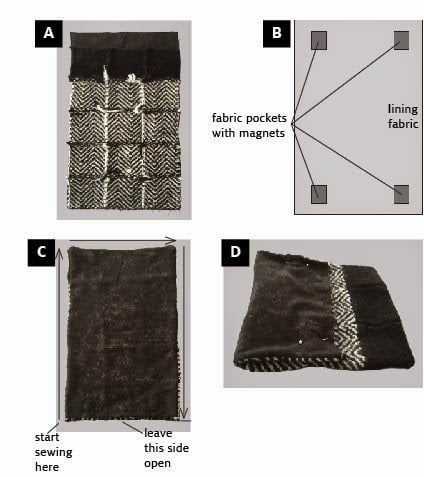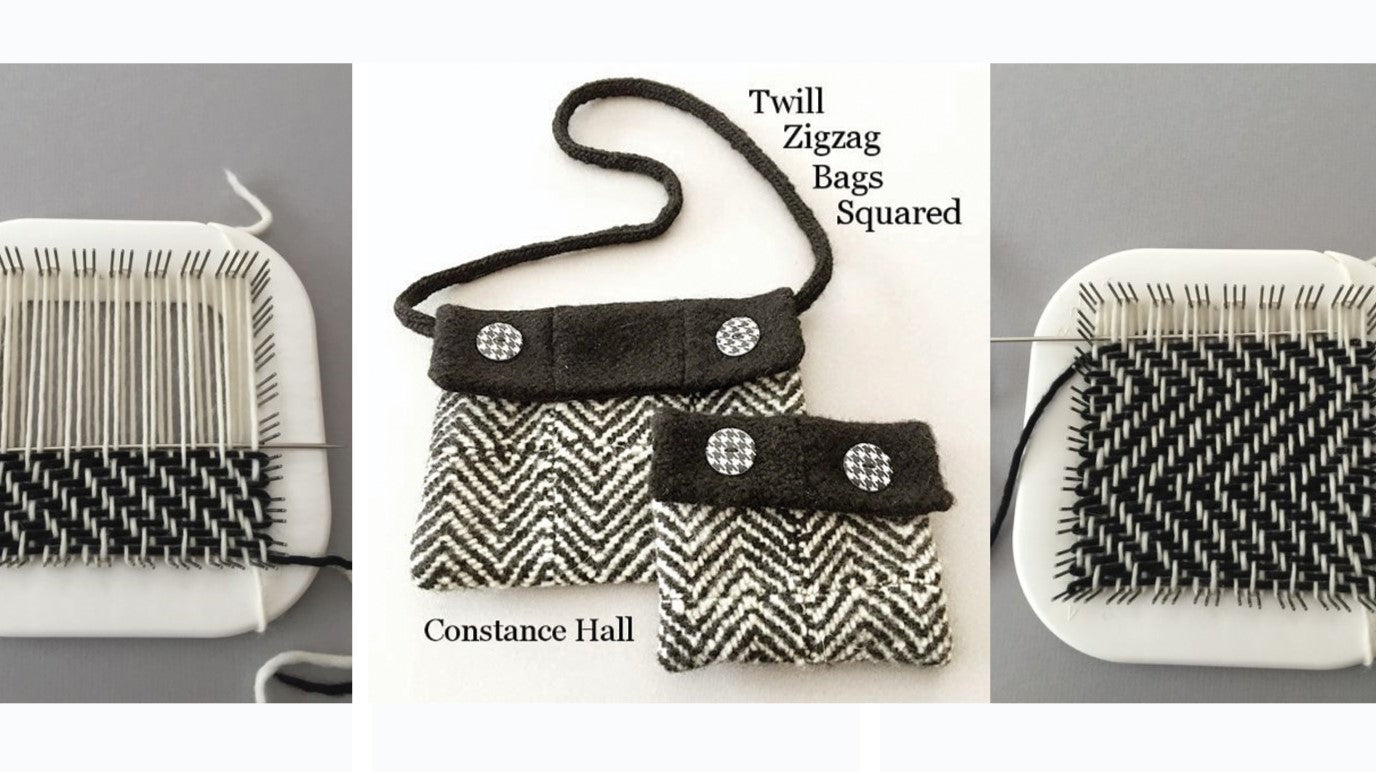Twill Zigzag Bag Squared
By Constance Hall
These bags explore twill weave (the zigzag) on the Zoom Loom. We love the contrasting solid black with the graphic black and white, which is so in this spring.
The sample bags are woven with a zigzag twill pattern in the black and the black and natural squares. You can weave the solid black squares in plain weave if you prefer. The closures used are magnets, but snaps or buttons and loops could be used.
Project Specs
Finished size: large bag, 8-1/2" x 6-1/2"; small bag, 5-1/2" x 5"
What You'll Need
-
Malabrigo Worsted (100g/210yds); 63 Natural and 195 Black, 1 skein each. The large bag requires 162 yards black, 108 yards natural; the small bag requires 90 yards black, 54 yards natural.
-
lining fabric
-
2 buttons per bag
-
4 Super Magnets per bag
-
Zoom Loom
-
sewing needle and thread or sewing machine
Materials and Equipment
Directions
Zigzag Twill
With natural yarn, warp the 1st layer as in the Zoom Loom instructions.
Turn the loom 180 degrees. Go around the 1st pin and warp this layer as in the Zoom Loom instructions for the third layer.
Break the yarn, leaving a 3" tail, and tape the tail to the back of the loom, out of the way. Wrap black yarn around the outside of pins 9 times to measure yarn needed for weaving.Weave with the black yarn as follows:
Row 1: [U1, O1] straight across, go around the bottom corner pin to lock the yarn down, and back through large space.
Row 2: [O2, U2] across, ending with U1
Row 3: O1, U1, [O2, U2] across, ending with O1
Row 4: [U2, O2] across, ending with O1
Row 5: U1, O1, [U2, O2] across, ending with U1
Row 6: [O2, U2] across, ending with U1
Row 7: O1, U1, [O2, U2] across, ending with O1
Row 8: [U2, O2] across, ending with O1
Row 9: U1, O1, [U2, O2] across, ending with U1
Row 10: [O2, U2] across, ending with U1
Row 11: O1, U1, [O2, U2] across, ending with O1
Switch twill direction here.
Row 12: U1, O1, [U2, O2] across, ending with U1
Row 13: [O2, U2] across, ending with U1
Row 14: O1, U1, [O2, U2] across, ending with O1
Row 15: [U2, O2] across, ending with O1
Row 16: U1, O1, [U2, O2] across, ending with U1
Row 17: [O2, U2] across, ending with U1
Row 18: O1, U1, [O2, U2] across, ending with O1
Row 19: [U2, O2] across, ending with O1
Row 20: U1, O1, [U2, O2] across, ending with U1
Row 21: [O2, U2] across, ending with U1
Row 22: O1, U1, [O2, U2] across, ending with O1
Change back to the original twill direction.
Row 23: U1, O1, [U2, O2] across, ending with U1
Row 24: [O2, U2] across, ending with U1
Row 25: O1, U1, [O2, U2] across, ending with O1
Row 26: [U2, O2] across, ending with O1
Row 27: U1, O1, [U2, O2] across, ending with U1
Row 28: [O2, U2] across, ending with U1
Row 29: O1, U1, [O2, U2] across, ending with O1
Row 30: [U2, O2] across, ending with O1
Row 31: U1, O1, [U2, O2] across, ending with U1
Row 32: O1, [U2, O2} across ending with U2It’s not necessary to change the direction of the twill with the solid black squares.
![Image of Weave with the black yarn as follows:Row 1: [U1, O1]...](https://f000.backblazeb2.com/file/recipekit-bucket/20231201181904-proj-20twill-20zigzag-20bag-20squared-20weaving-20steps.jpg?width=750)
Making the Outer Bag Fabric
For the large bag, make 3 black squares and 12 natural and black squares, using the zigzag twill pattern. For the small bag, make 2 black squares and 6 natural and black squares. (Black squares can be zigzag twill or plain weave.)
When weaving the black and natural squares, make sure to warp with the same color each time.
Arrange the squares in a rectangle 3 squares across by 5 squares down. Place all black squares across the top, with the beginning yarn tails at top left corners and the ending yarn tails at the top right corners [A]. Make sure the zigzag pattern is flowing from one square to the next. Sew the squares together using a very small seam allowance, either on the sewing machine or by hand.

Wash the sewn rectangle in hot water with a little dish soap. Agitate for a few minutes, then check the amount of felting. The fabric should thicken, but not shrink much. Repeat the agitation until done. Do not overdo or the twill pattern will be blurred. Rinse to remove soap, then roll in a towel to remove water. Straighten the sides and lay flat to dry.
Finishing the Bag
Cut the lining fabric 1/4" smaller than the felted rectangle. If using magnets, cut 4 small rectangles 1" x 2" or big enough to fit your magnets. Fold the small rectangles in half and pin onto the wrong side of the lining. Place two magnets at the top and two at the bottom [B in the diagram above]. Line them up so when the bag is folded the magnets will connect. Sew three sides of the small rectangles to the lining, insert the magnets and then stitch the last side.
- Place the lining on the fulled rectangle with right sides together. The lining is slightly smaller than the fabric. Line up one long side and sew using the smallest seam allowance possible [C]. Sew the sides in the order shown in [C], stretching the lining over to meet the edge of the fulled rectangle. Leave the bottom edge unsewn.
- Turn the bag right side out. On the unsewn side, fold the edges of the lining and fulled fabric to the inside and hand stitch the edge closed.
- With the lining outside, fold up the bottom of the bag to align the bottom edge almost to the spot where the black squares start [D]. Hand sew the side seams and turn the bag right side out. Fold the black end over to form a flap and sew on decorative buttons.
Optional handle: Cast on 5 stitches and knit I-cord to the length desired. Bind off and sew the handle onto the lining on the inside of the bag.

